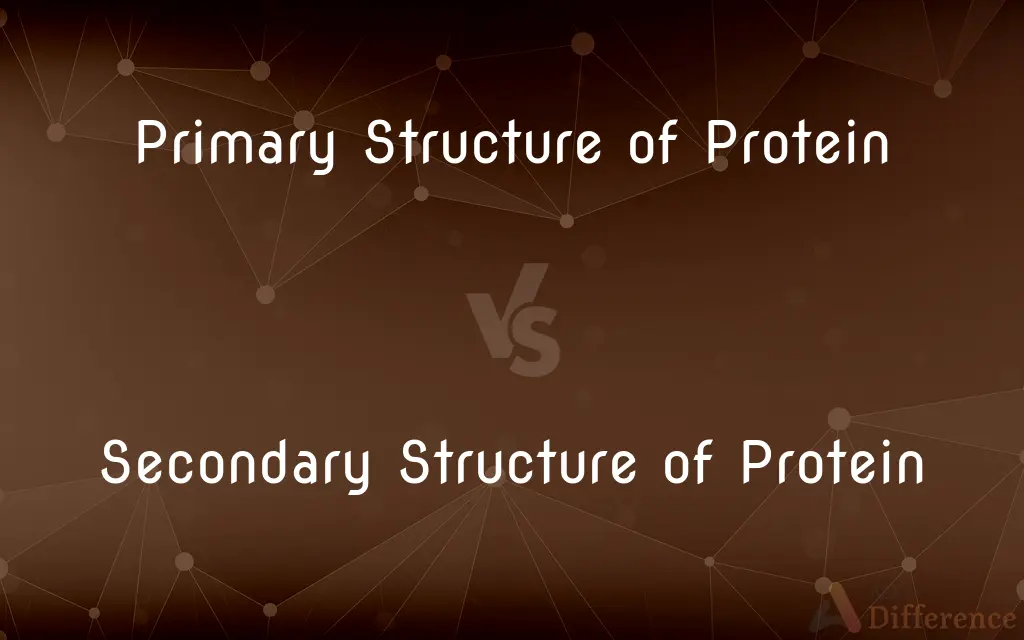Primary Structure of Protein vs. Secondary Structure of Protein — What's the Difference?
By Fiza Rafique & Urooj Arif — Published on February 24, 2024
The primary structure of protein refers to its linear sequence of amino acids, determined by genetic information. The secondary structure involves the coiling of the peptide chain into α-helices and -pleated sheets, stabilized by hydrogen bonds.

Difference Between Primary Structure of Protein and Secondary Structure of Protein
Table of Contents
ADVERTISEMENT
Key Differences
The primary structure is the most basic level of protein organization, representing the unique sequence of amino acids in a polypeptide chain. This sequence is directly encoded by the organism's genetic material and dictates how the protein will fold into its final three-dimensional shape.The secondary structure arises from hydrogen bonding between the backbone atoms of the peptide chain, leading to the formation of α-helices and β-pleated sheets.
The primary structure holds the information necessary for the protein's specific function, as even a single amino acid change can significantly affect the protein's activity and interactions. Secondary structures are key elements of the protein's overall architecture, contributing to its stability and function. The α-helix is a right-handed coil where each turn of the helix is stabilized by hydrogen bonds, while β-pleated sheets are formed by linking two or more strands of the protein chain side by side, also stabilized by hydrogen bonds.
The relationship between the primary and secondary structures is critical, as the sequence of amino acids (primary structure) influences the formation of hydrogen bonds, thus determining the patterns of folding or coiling (secondary structure). The secondary structure adds to the protein's complexity and is a step towards its functional three-dimensional conformation.
Both levels of structure are essential for the protein's biological activity. The primary structure ensures the correct sequence of amino acids, allowing the protein to adopt specific secondary structures necessary for its stability and function. Together, these structures play a fundamental role in the protein's final three-dimensional shape, which is crucial for its role in biological processes.
Comparison Chart
Definition
Linear sequence of amino acids
Folding or coiling patterns in the polypeptide chain
ADVERTISEMENT
Stabilizing Forces
Peptide bonds between amino acids
Hydrogen bonds between backbone atoms
Components
Amino acids
α-helices and β-pleated sheets
Dependency
Determined by genetic information
Influenced by the primary structure
Role in Protein Function
Dictates folding and final shape
Adds stability and shape to the protein
Impact of Alterations
Can significantly change protein function
Affects protein stability and function
Examples
Sequence of insulin
α-helix in keratin, β-sheet in silk
Compare with Definitions
Primary Structure of Protein
A sequence of amino acids in a polypeptide chain.
The primary structure of hemoglobin includes a specific sequence that binds oxygen.
Secondary Structure of Protein
Influenced by the primary structure.
The presence of proline can disrupt an α-helix due to its rigid structure.
Primary Structure of Protein
Determined by DNA.
Mutations in DNA can alter the primary structure and function of enzymes.
Secondary Structure of Protein
Stabilized by hydrogen bonds.
Hydrogen bonds between the carbonyl oxygen and amide hydrogen create the β-pleated sheet.
Primary Structure of Protein
Can be altered by mutations.
A single mutation in the β-globin gene changes the primary structure of hemoglobin, causing sickle cell disease.
Secondary Structure of Protein
Forms structural motifs.
β-hairpins in antifreeze proteins prevent ice crystal formation in polar fish.
Primary Structure of Protein
Basis for protein function.
The enzyme's active site is formed based on its amino acid sequence.
Secondary Structure of Protein
Folding patterns of the protein backbone.
The α-helix structure in myoglobin contributes to oxygen storage.
Primary Structure of Protein
Encodes the three-dimensional structure.
The primary structure of a protein determines its spatial configuration through folding.
Secondary Structure of Protein
Contributes to the protein's overall shape.
The coiling of an α-helix affects how a protein interacts with its environment.
Common Curiosities
How does the primary structure determine the secondary structure?
The sequence of amino acids dictates how the chain will fold or coil, as certain sequences favor the formation of α-helices or β-pleated sheets due to hydrogen bonding patterns.
Are all proteins composed of α-helices and β-pleated sheets?
Most proteins contain regions of α-helices and β-pleated sheets, but some parts may remain unstructured or form other types of secondary structures.
What happens if there is a mutation in the primary structure?
A mutation can change the amino acid sequence, potentially altering the protein's folding, stability, and function, which can lead to diseases.
How are the structures of proteins studied?
Techniques such as X-ray crystallography, nuclear magnetic resonance (NMR) spectroscopy, and cryo-electron microscopy are used to study protein structures at various levels of detail.
Do environmental factors affect the primary and secondary structures of proteins?
Environmental factors like pH, temperature, and solvent can affect the secondary structure by disrupting hydrogen bonds, indirectly impacting the primary structure's expression in the protein's folding and function.
Is the formation of the secondary structure a spontaneous process?
Yes, the formation of the secondary structure is largely spontaneous, driven by the physicochemical properties of the amino acids and their sequence in the primary structure, although it can be assisted by molecular chaperones in the cell.
What is the significance of rare secondary structures like 310 helices and π helices?
Rare secondary structures like 310 and π helices play specific roles in proteins where they occur, often involved in the function or stabilization of the protein's 3D structure, despite being less common than α-helices and β-sheets.
Can a protein function properly if its secondary structure is altered?
Alterations in the secondary structure can disrupt the protein's stability and function, potentially leading to loss of activity or misfolding diseases.
Why is the secondary structure important for protein function?
The secondary structure provides the scaffold necessary for the tertiary structure, influencing the protein
How is the secondary structure predicted from the primary structure?
Algorithms and bioinformatics tools, such as Chou-Fasman and GOR method, predict secondary structure based on the propensity of certain amino acids to form α-helices, β-sheets, or turns.
Can proteins still function if part of their secondary structure is missing?
Some proteins can tolerate alterations in their secondary structure to a degree without losing function, especially if these alterations occur outside of their active or binding sites. However, significant changes can lead to dysfunction.
How do proteins transition from primary to secondary structure during synthesis?
As the polypeptide chain emerges from the ribosome, it begins to fold spontaneously into its secondary structure, driven by the hydrophobic effect and stabilized by hydrogen bonding, even before synthesis is complete.
What role does the secondary structure play in protein aggregation?
The secondary structure influences protein aggregation, where misfolding or improper β-sheet formation can lead to diseases like Alzheimer's, characterized by amyloid fibril formation.
How do intrinsically disordered proteins fit into the classification of primary and secondary structures?
Intrinsically disordered proteins lack a fixed or ordered three-dimensional structure under physiological conditions and can contain regions that do not adopt regular secondary structures, highlighting the importance of the primary structure in determining protein function even in the absence of stable secondary or tertiary structures.
Can the primary structure of a protein be experimentally determined?
The primary structure can be determined using methods like Edman degradation for small proteins or peptides and mass spectrometry or DNA sequencing for larger proteins.
Share Your Discovery

Previous Comparison
Google Fi vs. T-Mobile
Next Comparison
Nascent Iodine vs. Lugol’s IodineAuthor Spotlight
Written by
Fiza RafiqueFiza Rafique is a skilled content writer at AskDifference.com, where she meticulously refines and enhances written pieces. Drawing from her vast editorial expertise, Fiza ensures clarity, accuracy, and precision in every article. Passionate about language, she continually seeks to elevate the quality of content for readers worldwide.
Co-written by
Urooj ArifUrooj is a skilled content writer at Ask Difference, known for her exceptional ability to simplify complex topics into engaging and informative content. With a passion for research and a flair for clear, concise writing, she consistently delivers articles that resonate with our diverse audience.
















































